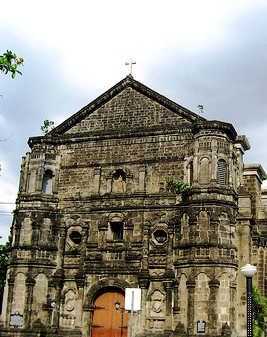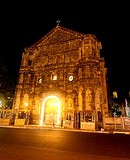Malate Church, do you know it's history?
The Philippines is the largest Catholic nation in Asia and Malate Church is one of the more impressive showcases of a religious devotion, which is now four and a half centuries old.
That faith was one of the more precious gifts from Spain, evident from the fact that the vast majority of Filipinos remain church-going Catholics notwithstanding waves of Jehovah’s Witnesses, Protestant Ministers and revivalists that have come visiting.
The people pride themselves in their faith and why shouldn’t they?
The Church has ever been a last recourse of the oppressed and the tipping point for the epochal People Power Revolution of 1986. Devotion to their religion is definitely a pillar of Filipino life. Being devout to their faith, the Philippines is also renowned for the churches built all around the country and that stand majestically all over the otherwise-Westernized
Manila metropolitan area.
One of the more notable shrines is Malate Church, aptly enough consecrated to the patroness of “
Ultimate Remedies”.

Malate Church is a baroque-style church fronting a park beyond which is Manila Bay. Malate Church was originally built in 1591, the first to be constructed outside the center of government,
Intramuros. As with most such churches around old Manila, its history and patroness are distinctive.
Dating from the original construction, Malate Church is one of the oldest churches in the Philippines. Although the present weathered church is only around 100 years old, its history goes back to the 16th century.
You might find that odd, even unbelievable, but yes, the 100-year-old structure has over 400 years of history.
“How?” you may ask.
The answer is that the Augustinian order of friars rebuilt the Church in Malate, like any other church built in coastal villages during the Spanish period, both as a shrine for the faithful in the southern reaches of the capital and also as a refuge.
After all, Muslim pirates from the South went on marauding slave hunts for centuries. And they still do, as that 2001 Abu Sayyaf raid of Dos Palmas, Palawan to kidnap tourists for ransom shows.
Hence, the coastal and riverside churches of the time had to be sturdy as fortresses, able to withstand the rudimentary
“lantaka” cannon of the pirate tribes until help could be summoned.

Thrice, Malate Church endured total destruction. After serious damage in the earthquake of 1645, Malate Church was rebuilt with brick and stone by 1680.
It was this church that the British expeditionary force of 1762 used as a base when they landed a safe distance south of the guns of Intramuros. The landing site happened to be the beach fronting the Church in Malate. From Malate, they went on to invest and occupy Intramuros for two years.
In 1868, another earthquake and a tropical cyclone in succession combined to demolish the church yet again.
The Augustinians proved tireless in rebuilding and there Malate Church stood until the liberation of Manila from the Japanese in World War II.
The combination of mortar attacks by Filipino guerillas and unrelenting naval and aerial bombardment by the Americans (nobody had heard to avoid collateral damage then) started a fire that razed the church and numerous other historic buildings around Manila.
In the 1950s, the Columbian order restored the church along the old lines.
Yes, this church has definitely seen ups and downs.
Nuestra Señora de Remedios
The shrine is dedicated to Nuestra Señora de Remedios, Our Lady of Remedies.
The Nuestra Señora de Remedios is one of many images of the Virgin Mary, whom the Filipino people venerate. Under this designation, she is traditionally counted the patroness of women in labor and childbirth.
The Virgin Mary has been a pillar of support during times of trouble. A statue of the Virgin Mary still stands at the altar, an image brought from Spain to the Philippines in the year 1624; this has survived natural disasters and two invasions.
Unbelievable yet true!
Malate Church now
In modern times, this portion of the Malate district received a facelift when the American colonial government made the area a showcase of urban planning, a rational street grid and an otherwise pleasant residential enclave for themselves and well-off Filipinos.
The older generation has therefore seen its share of baptisms, weddings and Requiem masses solemnized in this grand structure. Vestiges of that privileged cachet still survive today when middle-class families decide Malate Church is the best venue they can have for a wedding.
All in all, the Church is a place to visit if you are interested in a shrine that has played a role in local history.
People just pass by the church and never really know what the church is all about. But once you know the history, the Church in Malate clearly has more than meets the eye.
Return to Philippines Travel Guide Home Page.
Enjoy this page? Please pay it forward. Here's how...
Would you prefer to share this page with others by linking to it?
- Click on the HTML link code below.
- Copy and paste it, adding a note of your own, into your blog, a Web page, forums, a blog comment,
your Facebook account, or anywhere that someone would find this page valuable.
 Malate Church is a baroque-style church fronting a park beyond which is Manila Bay. Malate Church was originally built in 1591, the first to be constructed outside the center of government, Intramuros. As with most such churches around old Manila, its history and patroness are distinctive.
Malate Church is a baroque-style church fronting a park beyond which is Manila Bay. Malate Church was originally built in 1591, the first to be constructed outside the center of government, Intramuros. As with most such churches around old Manila, its history and patroness are distinctive.


